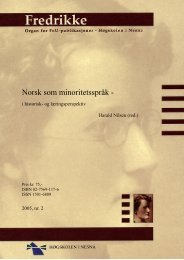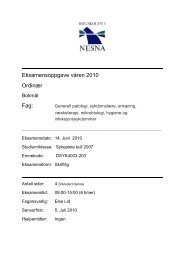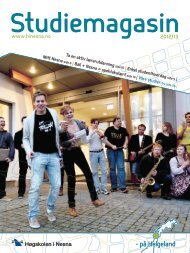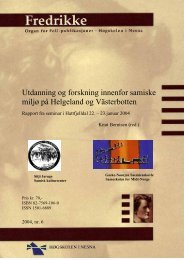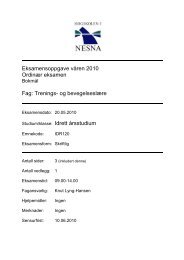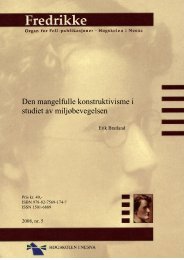ikt-basert norskundervisning i utlandet - Høgskolen i Nesna
ikt-basert norskundervisning i utlandet - Høgskolen i Nesna
ikt-basert norskundervisning i utlandet - Høgskolen i Nesna
Create successful ePaper yourself
Turn your PDF publications into a flip-book with our unique Google optimized e-Paper software.
35<br />
We have mostly used asynchronous communication in the process of teaching Norwegian in<br />
Lithuania, so this part of the report deals mostly with different means of asynchronous<br />
communication.<br />
Following means of asynchronous communication via Internet might be singled out:<br />
• electronic mail (aka e-mail):<br />
• usual correspondence via e-mail<br />
• mailing lists<br />
• newsgroups<br />
• on-line questionnaire-forms<br />
• forums (aka message boards),<br />
• lists of frequently asked questions and answers (the so-called FAQs)<br />
• on-line diaries (aka web-logs or blogs)<br />
This kind of communication means is provided both by special systems, which are<br />
specifically orientated towards education (e. g., ), and free-of-charge<br />
(usually ad-supported) systems, which orientate themselves towards the ordinary user<br />
(, , and many<br />
others).<br />
Besides this, the Internet is a perfect means to became acknowledged not only with the<br />
language(s) which one is studying, but also with the country (-ies) where this/these<br />
language(s) is/are used, the culture, the history and today's news of the corresponding<br />
countries:<br />
• e-libraries, e-corpora – great examples of which are:<br />
„Runeberg“ ,<br />
„Gutenberg“ ,<br />
„Perseus“ ,<br />
„Netútgáfan“ and others,<br />
• e-media.<br />
Therefore a good collection of relevant URLs may be one of the most important and useful<br />
accents of a site devoted to the studies of a foreign language, e. g. Norwegian.<br />
This report is not based on any exhaustive or special research, so it is by no means a scholarly<br />
research paper. We would simply like to share our experience about how we make use of<br />
Internet in practice, and what kind of impact it has on the process of studying the Norwegian<br />
language at Vilnius University (and partly at Vytautas Magnus University in Kaunas, where<br />
Ugnius Mikucionis also is employed, although the latter institution has not participated in the<br />
ICT-project).<br />
Communication may be direct (when the conversation partners are in the same space, they can<br />
see and / or hear each other directly) and indirect (when the conversation partners are not in<br />
the same space and use some kind of media or equipment when communicating – letters,<br />
phone connection, telegraph, fax, Internet or other). One type of indirect communication is<br />
communication over the Internet. Indirect communication may be either synchronous (when<br />
the conversation partners participate in the conversation or dialogue in real time, e. g., using<br />
phone, taking part in a television bridge, video or audio conference over Internet, or simply<br />
flirting in a chat channel) or asynchronous (when the participants leave messages or answer to<br />
messages, previously left by other people, e. g., by e-mail or at Internet forums or message<br />
boards).<br />
Fredrikke nr. 11, 2005<br />
Organ for FoU-publikasjoner – <strong>Høgskolen</strong> i <strong>Nesna</strong>






